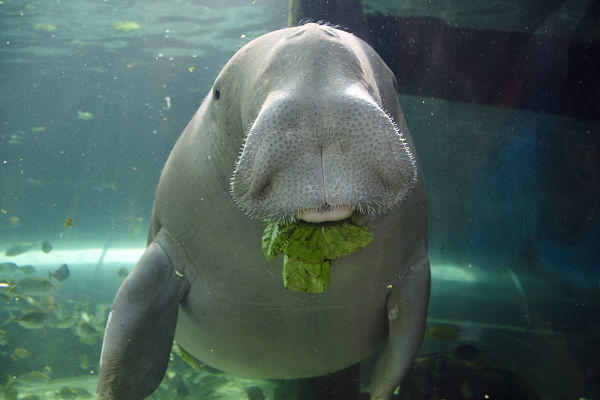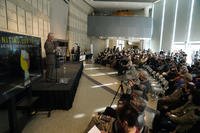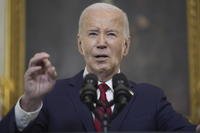The survival of Okinawa's dugongs, protected shallow-water mammals similar to Florida's manatees, has become a major sticking point in the U.S. Marines' progress toward building a new airfield on Okinawa that Defense Secretary Chuck Hagel called "absolutely critical" to the rebalance of forces to the Pacific.
Last week, Okinawa residents opposed to the airfield and the U.S. military presence on the island filed suit in the Japanese courts in an effort to derail the plan to replace the Futenma Marine Air Station with a new V-shaped runway to be built with landfill on Oura Bay, next to the Marines’ Camp Schwab.
The lawsuit cited the threat to the safety of the dugongs' habitat, Stars and Stripes reported.
"This is a milestone in our continued fight to stop the construction of a new military base in Henoko," said Hiroshi Ashitomi, who led the plaintiffs in the lawsuit.
"Our struggle to stop the construction of a new military base on Okinawa is destined to win because it is the consensus of 1.4 million people of Okinawa," Ashitomi said.
The opposition group also planned to file a second lawsuit in U.S. District Court in San Francisco seeking to protect the dugongs as an endangered species.
The Futenma replacement airfield was dealt another setback last Sunday when Nago Mayor Susumu Inamine won re-election, defeating a candidate backed by Japanese Prime Minister Shinzo Abe.
"This election was easy to understand. It was about one issue, the Henoko issue, and whether you were for or against the new base," Inamine told cheering supporters, the Japan Times reported. "The people have spoken and they have said no."
In the campaign, Inamine had charged that Abe won the approval of Okinawa Gov. Hirokazu Nakaima for the Futenma replacement and the proposal to shift 4,500 Marines off the island to Guam with "sweeteners" amounting to pledges of $22.3 billion for Okinawan economic development over 10 years.
When the Futenma deal was announced in late December, Hagel said the so-called "Pacific pivot" of U.S. forces hinged on the new airfield on Okinawa for Marine MV-22 Opsrey tilt-rotors and other aircraft.
"The re-alignment effort is absolutely critical to the United States' ongoing rebalance to the Asia-Pacific region" to counter the rise of China and maintain U.S. blue-water supremacy in Asia, Hagel said in a statement.
As part of the Okinawa deal, the Tokyo government also agreed to put up more than $3 billion of the estimated $8 billion-plus cost over 10 years of moving 4,500 Marines to Guam and building up facilities there, but that long-stalled arrangement faces its own additional delays in the U.S. Senate.
In the National Defense Authorization Act approved late last year, the Senate Armed Services Committee included language stating that no Japanese or U.S. money for the Guam move could be spent until Hagel submitted a "master plan" on the project
The master plan would have to include detailed "descriptions of work, costs, and a schedule for completion of construction, improvements, and repairs to the non-military utilities, facilities, and infrastructure, if any, on Guam affected by the realignment of forces," the committee stated.
Despite the master plan requirements, Rep. Madeleine Z. Bordallo, Guam's delegate to the U.S. House of Representatives, said the NDAA still authorizes the appropriation this year of $494.6 million in military construction funds for Guam, including $85.6 million for a Marine aircraft hangar at Guam's Andersen Air Force Base.
In a statement, Bordallo said that the money for Guam "demonstrates to our allies in the region that we are serious about the rebalance strategy and we are putting significant resources toward this strategic initiative."
The strategy is still very much in flux, Adm. Samuel Locklear, head of the U.S. Pacific Command, told the Surface Navy Association Annual Symposium in Washington D.C. last week.
"China is going to rise, we all know that. [But] how are they behaving? That is really the question," Locklear said in a reference to China's declaration of an Air Defense Identification Zone and Beijing's increasingly confrontational disputes with neighbors over contested islands in the East and South China Seas.
"Our historic dominance that most of us in this room have enjoyed is diminishing, no question," Locklear said.
Earlier this month at Camp Pendleton, Calif., Navy Secretary Ray Mabus told Marines departing for Afghanistan that a key part of the Pacific rebalance will be a return to their traditional expeditionary role aboard ships as part of naval Amphibious Ready Groups and Marine Expeditionary Units following the land wars in Afghanistan and Iraq.
Mabus said he envisioned building the ARG fleet to 33 ships of various amphibious classes. The ships would enable the Navy to have four ARGs worldwide, including a four-ship ARG for the Pacific, Mabus said.
At the "All-Hands" meeting with Mabus at Pendleton, a Marine Lance Corporal asked about the timing of the move to Guam. Mabus said it would be a while, joking that "you'll be a gunnery sergeant" before that happens.





























